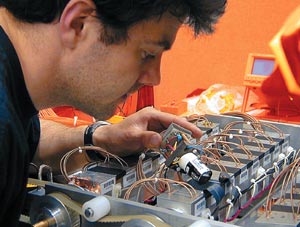The CMS experiment, under construction for the Large Hadron Collider (LHC) at CERN, recently took delivery of its 10,000th vacuum phototriode (VPT), to be used in the Electromagnetic Endcap Calorimeter. The occasion was marked by a seminar organised in St Petersburg by the VPT manufacturer, National Research Institute Electron. The manufacturing programme is scheduled for completion in early 2006, when a total of 15,500 devices will have been delivered.

The VPT is a single-stage photomultiplier, developed for CMS by groups at the Rutherford Appleton Laboratory, Brunel University and the Petersburg Nuclear Physics Institute, Gatchina. In CMS, each VPT will be bonded to a scintillating lead-tungstate crystal supplied by the Bogoroditsk Techno-Chemical Plant, also in Russia. Each CMS endcap will contain 7324 such crystals and VPTs.
The LHC will provide a very demanding environment for the detectors: they must operate for 10 years under intense gamma and neutron irradiation, and in a magnetic field of 4 T.
In addition, the beam-crossing rate of 40 MHz means that the VPTs must respond to light signals on a timescale of a few nanoseconds. Only a few manufacturers in the world are able to meet the technical requirements of the CMS experiment.
The seminar in St Petersburg was attended by representatives of CERN, the CMS experiment, NRI Electron, and OJSC Russian Electronics, the holding company of both NRI Electron and Bogoroditsk Techno-Chemical Plant. At the end of the seminar, the Russian Academy of Engineering Science gave a special award to Hans Rykaczewski, the CMS-ECAL resources manager, to recognize his contribution to the collaboration between CERN and Russian industry.





